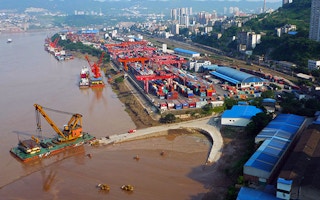Transport ministers from across Asia and the Pacific are meeting this week to consider a potentially transformational agenda for how people and goods are moved around the region and across the globe.
Pre-COVID-19 transport connectivity weaknesses in the Asia-Pacific region became even more apparent during the pandemic. Landlocked developing countries, least developed countries and developing island states were affected. It is imperative that we accelerate meaningful change in our transport systems as countries seek to put their development agendas back on track.
It is against this backdrop that officials meeting at the United Nation’s Economic and Social Commission for Asia and the Pacific (ESCAP) for the fourth Ministerial Conference on Transport are debating a Regional Action Programme (RAP) for 2022 to 2026. It will be a new roadmap for a transport system needed to attain the 2030 Agenda for Sustainable Development and the Sustainable Development Goals (SDGs).
The RAP would address issues such as increasing freight and passenger volumes, reflecting rising demand for freight transport and mobility. Two-thirds of global seaborne trade is now concentrated in Asia-Pacific, home to nine of the world’s busiest container ports. The region is responsible for more than 40 per cent of the global surface freight transport flows. By 2050, the continent’s demand for freight transport is projected to triple. Asia and the Pacific is expected to face greater trade exchanges, further substantial demographic growth and rapid urbanization coupled with high motorization rates in coming years.
To cope with such changes and demands, the RAP would encourage greater digitalization and innovation for transport. As the pandemic unfolded, we saw that accelerated adoption of digital technologies helped governments and private enterprises keep activities going amid border closures and other containment measures. Further deployment of smart transport systems to improve efficiency, resilience as well as social and environmental sustainability is undoubtedly a key priority for building back better.
Other key provisions of the RAP include speeding up transitions to low-carbon transport systems. The transport sector is one of the highest contributors to climate change and Asia and the Pacific remains among the highest carbon dioxide emitting regions in the world. There is a strong need for rapid decarbonization of the regional transport networks and related operations, including urban and public transport. Shifting to railways would also greatly boost sustainability of international freight transport and move to a more sustainable post-COVID-19 world. An abundance of renewable energy in some countries is an opportunity to switch to electric mobility in public transport. To support these efforts, the United Nations Economic and Social Commission for Asia and the Pacific (ESCAP) last month unveiled at the climate change conference in Glasgow plans for an Asia-Pacific Initiative on Electric Mobility.
The outbreak of COVID-19 had a profound impact on urban transport, accessibility and mobility. These challenges provide new momentum to transport and city planners to rethink forms of mobility as a service that is affordable, accessible, reliable and safe. Furthermore, gender gaps and inequalities in terms of access to transport and related opportunities persist, further inhibiting the capacity of the sector to equally address the social dimensions of sustainable development.
In the context of sustainable development, we cannot disregard the fact that 60 per cent of global road crash fatalities occur in the Asia and Pacific region. The General Assembly has proclaimed 2021 to 2030 as the Second Decade of Action for Road Safety, with a goal of cutting by half road traffic deaths and injuries. In response, ESCAP is preparing an Asia-Pacific Regional Plan of Action.
International freight transport remained largely operational throughout the pandemic, as countries took policy measures to preserve freight transport connectivity to support supply chains. The Asian Highway, Trans-Asian Railway and dry port networks established under ESCAP auspices serve as the backbone for land transport infrastructure connectivity and logistics in the region. They are also increasingly integrated with inter-regional transport corridors and port and shipping networks. In 2020 and 2021, these links brought countries together to capture and analyze their responses to the pandemic and the impacts of those actions on regional connectivity. Moving forward, they can be further leveraged to promote infrastructure and operational connectivity reforms in support of a seamless integrated web of intermodal transport connections underpinning the regional and global economy.
The COVID-19 pandemic disrupted progress in Asia and the Pacific towards many of the Sustainable Development Goals and, in some cases, reversed years of achievement. The transport sector, which is instrumental to attaining the SDGs, took a significant hit during the pandemic, but countries demonstrated an ability to move swiftly towards automation and innovation to maintain functionality and resilience, and support access to social inclusion. This also points to the capacity of the sector to take bold new steps towards low-carbon development. A new Regional Action Programme can prove to be pivotal in addressing the region’s lagging performance and enhancing resilience to future crises by reducing deep-rooted social, economic and environmental challenges.









